Nutrition and Diet Report: Analysis of Food Choices, Health, and Meals
VerifiedAdded on 2020/01/15
|21
|6536
|144
Report
AI Summary
This report delves into the multifaceted world of nutrition and diet, examining the factors that influence food choices, including socioeconomic, cultural, and psychological aspects. It categorizes foods based on type and nutritional content, assesses methods for measuring nutritional status, and outlines the nutritional requirements of various groups, such as children, young women, and individuals engaged in heavy manual labor. The report explores the intricate relationship between diet and health, explaining the principles of healthy eating and the effects of alcohol. Furthermore, it addresses the use of diet in managing medical conditions, plans and develops healthy meals, modifies existing menus, and evaluates the impact of food production methods on nutritional value. The report concludes by analyzing materials that provide nutritional information and promote healthy eating concepts, offering a comprehensive overview of the subject matter.
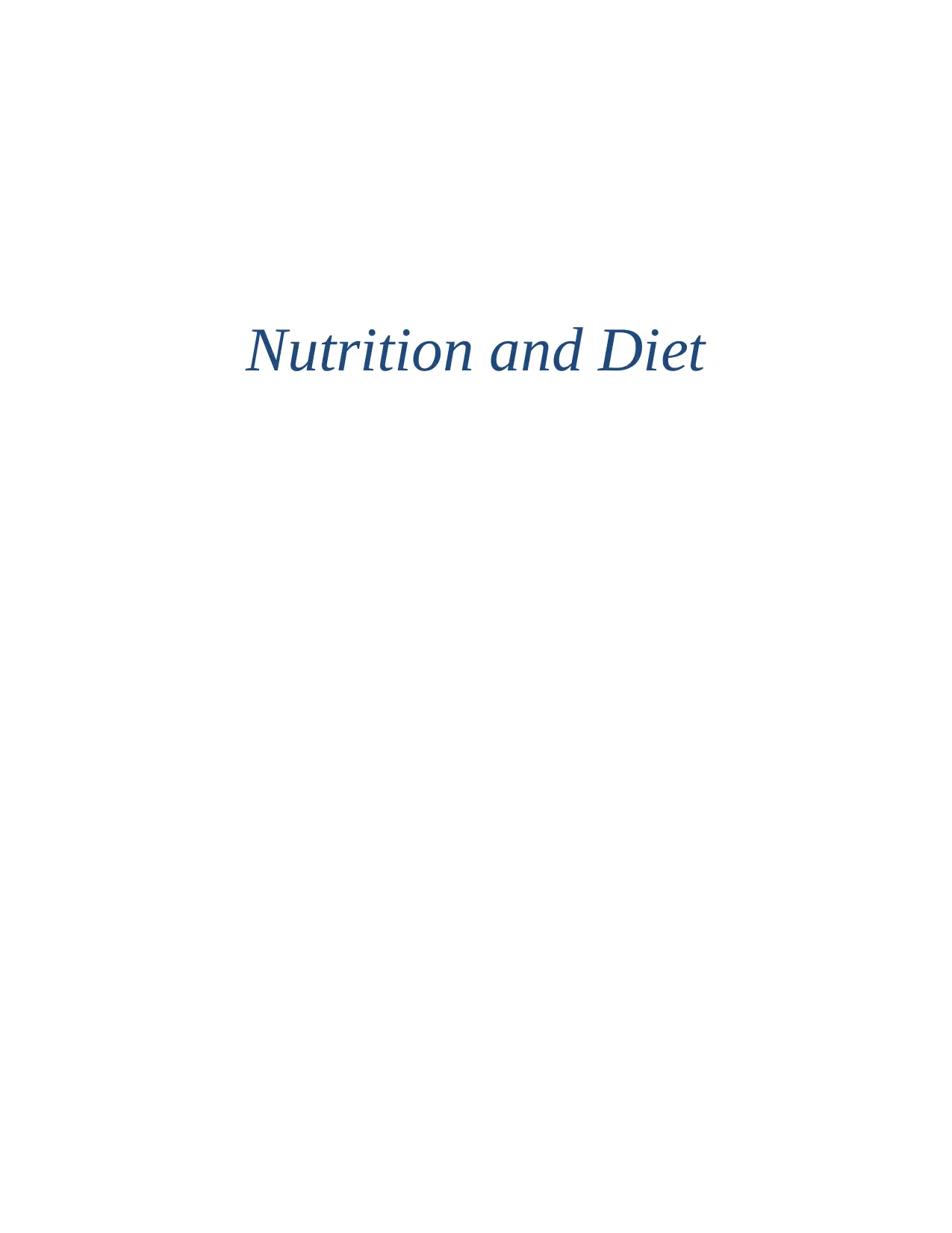
Nutrition and Diet
Paraphrase This Document
Need a fresh take? Get an instant paraphrase of this document with our AI Paraphraser
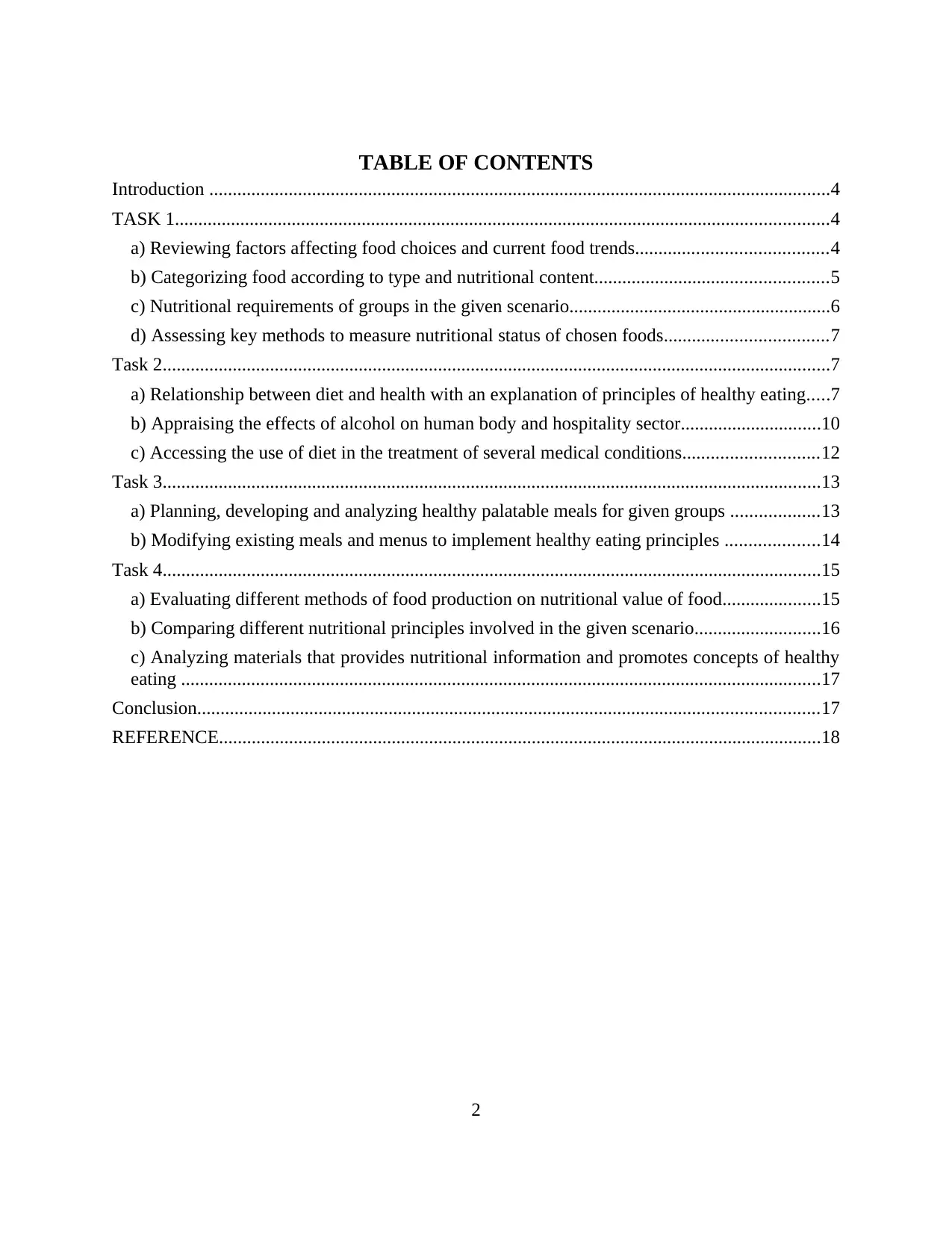
TABLE OF CONTENTS
Introduction .....................................................................................................................................4
TASK 1............................................................................................................................................4
a) Reviewing factors affecting food choices and current food trends.........................................4
b) Categorizing food according to type and nutritional content..................................................5
c) Nutritional requirements of groups in the given scenario........................................................6
d) Assessing key methods to measure nutritional status of chosen foods...................................7
Task 2...............................................................................................................................................7
a) Relationship between diet and health with an explanation of principles of healthy eating.....7
b) Appraising the effects of alcohol on human body and hospitality sector..............................10
c) Accessing the use of diet in the treatment of several medical conditions.............................12
Task 3.............................................................................................................................................13
a) Planning, developing and analyzing healthy palatable meals for given groups ...................13
b) Modifying existing meals and menus to implement healthy eating principles ....................14
Task 4.............................................................................................................................................15
a) Evaluating different methods of food production on nutritional value of food.....................15
b) Comparing different nutritional principles involved in the given scenario...........................16
c) Analyzing materials that provides nutritional information and promotes concepts of healthy
eating .........................................................................................................................................17
Conclusion.....................................................................................................................................17
REFERENCE.................................................................................................................................18
2
Introduction .....................................................................................................................................4
TASK 1............................................................................................................................................4
a) Reviewing factors affecting food choices and current food trends.........................................4
b) Categorizing food according to type and nutritional content..................................................5
c) Nutritional requirements of groups in the given scenario........................................................6
d) Assessing key methods to measure nutritional status of chosen foods...................................7
Task 2...............................................................................................................................................7
a) Relationship between diet and health with an explanation of principles of healthy eating.....7
b) Appraising the effects of alcohol on human body and hospitality sector..............................10
c) Accessing the use of diet in the treatment of several medical conditions.............................12
Task 3.............................................................................................................................................13
a) Planning, developing and analyzing healthy palatable meals for given groups ...................13
b) Modifying existing meals and menus to implement healthy eating principles ....................14
Task 4.............................................................................................................................................15
a) Evaluating different methods of food production on nutritional value of food.....................15
b) Comparing different nutritional principles involved in the given scenario...........................16
c) Analyzing materials that provides nutritional information and promotes concepts of healthy
eating .........................................................................................................................................17
Conclusion.....................................................................................................................................17
REFERENCE.................................................................................................................................18
2
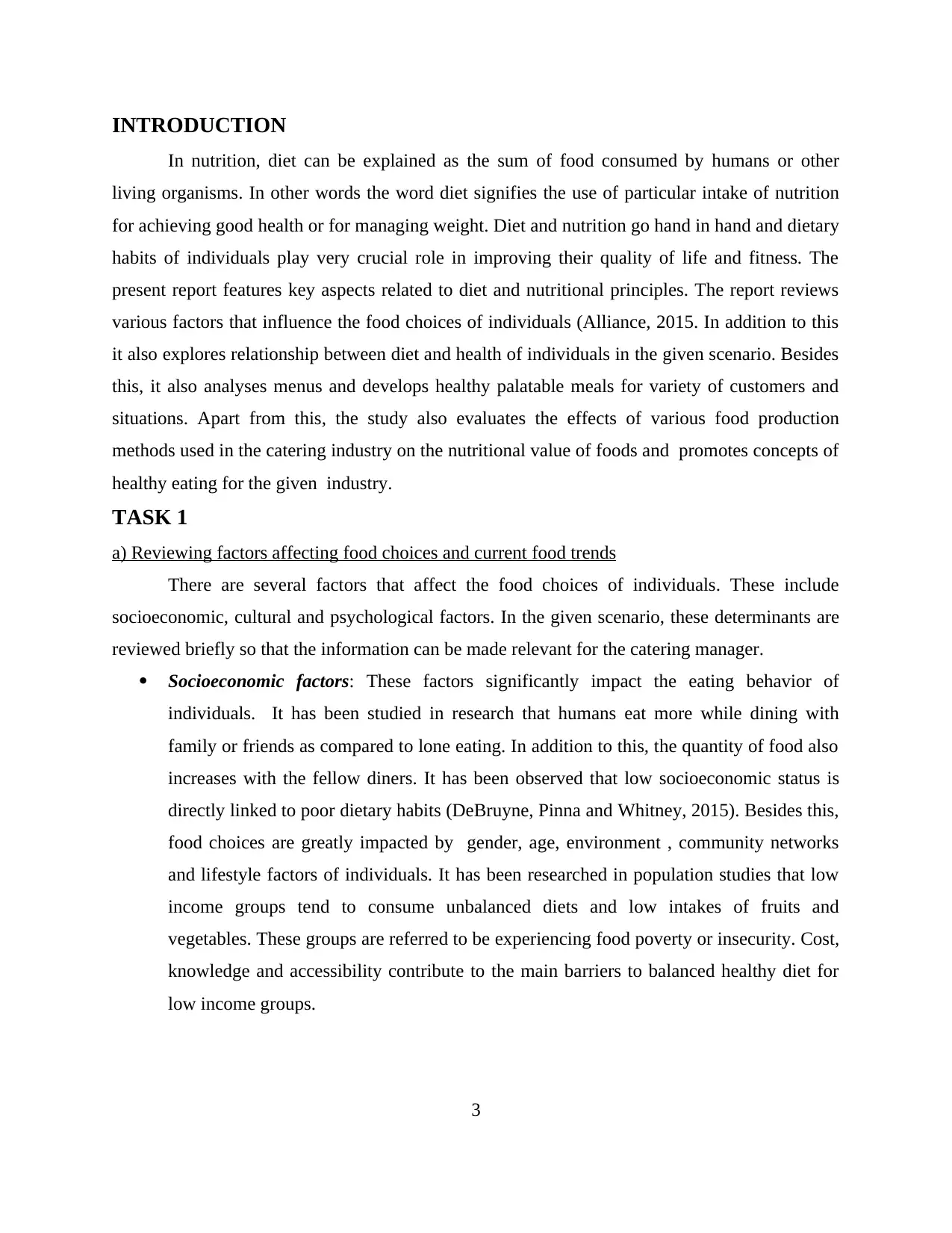
INTRODUCTION
In nutrition, diet can be explained as the sum of food consumed by humans or other
living organisms. In other words the word diet signifies the use of particular intake of nutrition
for achieving good health or for managing weight. Diet and nutrition go hand in hand and dietary
habits of individuals play very crucial role in improving their quality of life and fitness. The
present report features key aspects related to diet and nutritional principles. The report reviews
various factors that influence the food choices of individuals (Alliance, 2015. In addition to this
it also explores relationship between diet and health of individuals in the given scenario. Besides
this, it also analyses menus and develops healthy palatable meals for variety of customers and
situations. Apart from this, the study also evaluates the effects of various food production
methods used in the catering industry on the nutritional value of foods and promotes concepts of
healthy eating for the given industry.
TASK 1
a) Reviewing factors affecting food choices and current food trends
There are several factors that affect the food choices of individuals. These include
socioeconomic, cultural and psychological factors. In the given scenario, these determinants are
reviewed briefly so that the information can be made relevant for the catering manager.
Socioeconomic factors: These factors significantly impact the eating behavior of
individuals. It has been studied in research that humans eat more while dining with
family or friends as compared to lone eating. In addition to this, the quantity of food also
increases with the fellow diners. It has been observed that low socioeconomic status is
directly linked to poor dietary habits (DeBruyne, Pinna and Whitney, 2015). Besides this,
food choices are greatly impacted by gender, age, environment , community networks
and lifestyle factors of individuals. It has been researched in population studies that low
income groups tend to consume unbalanced diets and low intakes of fruits and
vegetables. These groups are referred to be experiencing food poverty or insecurity. Cost,
knowledge and accessibility contribute to the main barriers to balanced healthy diet for
low income groups.
3
In nutrition, diet can be explained as the sum of food consumed by humans or other
living organisms. In other words the word diet signifies the use of particular intake of nutrition
for achieving good health or for managing weight. Diet and nutrition go hand in hand and dietary
habits of individuals play very crucial role in improving their quality of life and fitness. The
present report features key aspects related to diet and nutritional principles. The report reviews
various factors that influence the food choices of individuals (Alliance, 2015. In addition to this
it also explores relationship between diet and health of individuals in the given scenario. Besides
this, it also analyses menus and develops healthy palatable meals for variety of customers and
situations. Apart from this, the study also evaluates the effects of various food production
methods used in the catering industry on the nutritional value of foods and promotes concepts of
healthy eating for the given industry.
TASK 1
a) Reviewing factors affecting food choices and current food trends
There are several factors that affect the food choices of individuals. These include
socioeconomic, cultural and psychological factors. In the given scenario, these determinants are
reviewed briefly so that the information can be made relevant for the catering manager.
Socioeconomic factors: These factors significantly impact the eating behavior of
individuals. It has been studied in research that humans eat more while dining with
family or friends as compared to lone eating. In addition to this, the quantity of food also
increases with the fellow diners. It has been observed that low socioeconomic status is
directly linked to poor dietary habits (DeBruyne, Pinna and Whitney, 2015). Besides this,
food choices are greatly impacted by gender, age, environment , community networks
and lifestyle factors of individuals. It has been researched in population studies that low
income groups tend to consume unbalanced diets and low intakes of fruits and
vegetables. These groups are referred to be experiencing food poverty or insecurity. Cost,
knowledge and accessibility contribute to the main barriers to balanced healthy diet for
low income groups.
3
⊘ This is a preview!⊘
Do you want full access?
Subscribe today to unlock all pages.

Trusted by 1+ million students worldwide
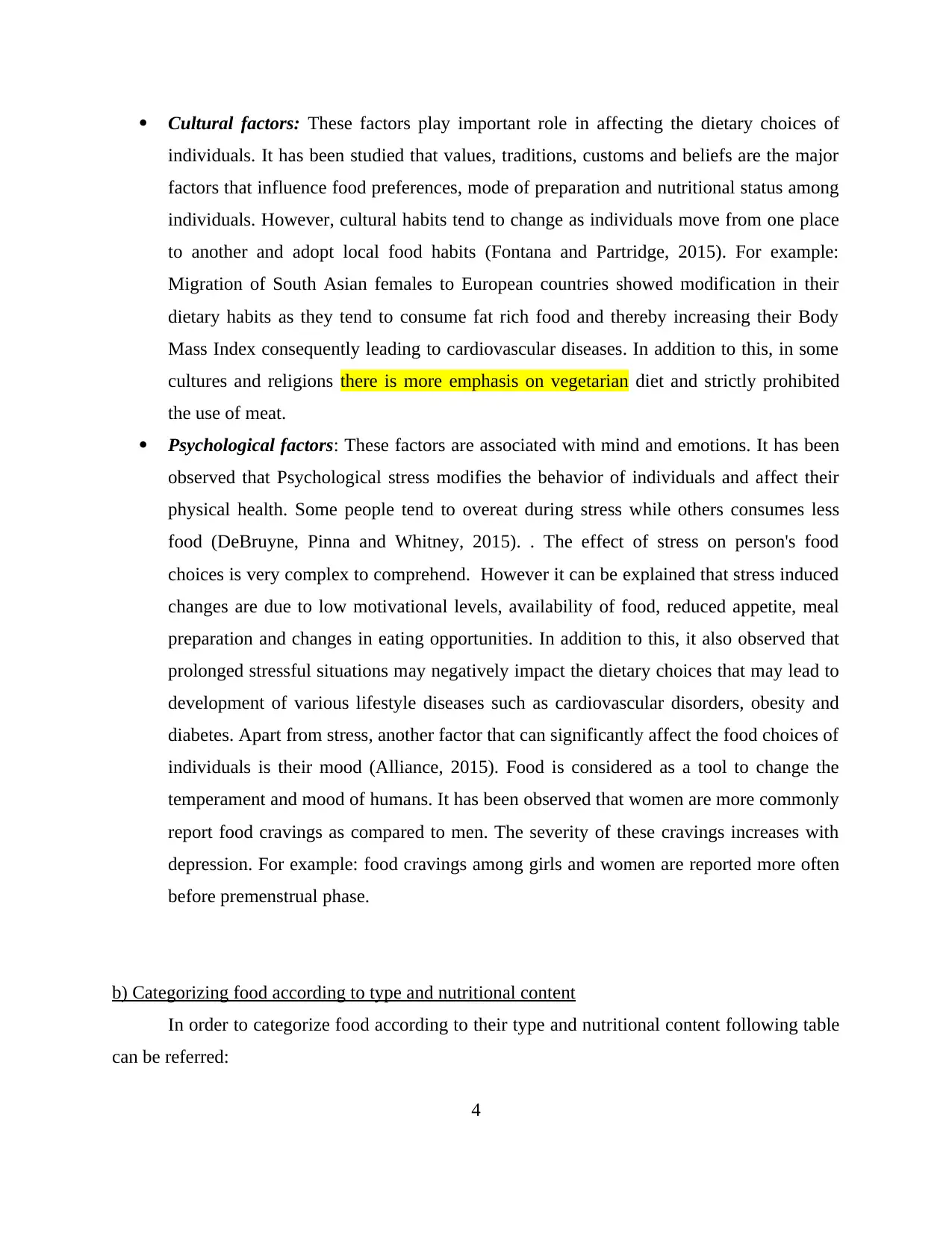
Cultural factors: These factors play important role in affecting the dietary choices of
individuals. It has been studied that values, traditions, customs and beliefs are the major
factors that influence food preferences, mode of preparation and nutritional status among
individuals. However, cultural habits tend to change as individuals move from one place
to another and adopt local food habits (Fontana and Partridge, 2015). For example:
Migration of South Asian females to European countries showed modification in their
dietary habits as they tend to consume fat rich food and thereby increasing their Body
Mass Index consequently leading to cardiovascular diseases. In addition to this, in some
cultures and religions there is more emphasis on vegetarian diet and strictly prohibited
the use of meat.
Psychological factors: These factors are associated with mind and emotions. It has been
observed that Psychological stress modifies the behavior of individuals and affect their
physical health. Some people tend to overeat during stress while others consumes less
food (DeBruyne, Pinna and Whitney, 2015). . The effect of stress on person's food
choices is very complex to comprehend. However it can be explained that stress induced
changes are due to low motivational levels, availability of food, reduced appetite, meal
preparation and changes in eating opportunities. In addition to this, it also observed that
prolonged stressful situations may negatively impact the dietary choices that may lead to
development of various lifestyle diseases such as cardiovascular disorders, obesity and
diabetes. Apart from stress, another factor that can significantly affect the food choices of
individuals is their mood (Alliance, 2015). Food is considered as a tool to change the
temperament and mood of humans. It has been observed that women are more commonly
report food cravings as compared to men. The severity of these cravings increases with
depression. For example: food cravings among girls and women are reported more often
before premenstrual phase.
b) Categorizing food according to type and nutritional content
In order to categorize food according to their type and nutritional content following table
can be referred:
4
individuals. It has been studied that values, traditions, customs and beliefs are the major
factors that influence food preferences, mode of preparation and nutritional status among
individuals. However, cultural habits tend to change as individuals move from one place
to another and adopt local food habits (Fontana and Partridge, 2015). For example:
Migration of South Asian females to European countries showed modification in their
dietary habits as they tend to consume fat rich food and thereby increasing their Body
Mass Index consequently leading to cardiovascular diseases. In addition to this, in some
cultures and religions there is more emphasis on vegetarian diet and strictly prohibited
the use of meat.
Psychological factors: These factors are associated with mind and emotions. It has been
observed that Psychological stress modifies the behavior of individuals and affect their
physical health. Some people tend to overeat during stress while others consumes less
food (DeBruyne, Pinna and Whitney, 2015). . The effect of stress on person's food
choices is very complex to comprehend. However it can be explained that stress induced
changes are due to low motivational levels, availability of food, reduced appetite, meal
preparation and changes in eating opportunities. In addition to this, it also observed that
prolonged stressful situations may negatively impact the dietary choices that may lead to
development of various lifestyle diseases such as cardiovascular disorders, obesity and
diabetes. Apart from stress, another factor that can significantly affect the food choices of
individuals is their mood (Alliance, 2015). Food is considered as a tool to change the
temperament and mood of humans. It has been observed that women are more commonly
report food cravings as compared to men. The severity of these cravings increases with
depression. For example: food cravings among girls and women are reported more often
before premenstrual phase.
b) Categorizing food according to type and nutritional content
In order to categorize food according to their type and nutritional content following table
can be referred:
4
Paraphrase This Document
Need a fresh take? Get an instant paraphrase of this document with our AI Paraphraser
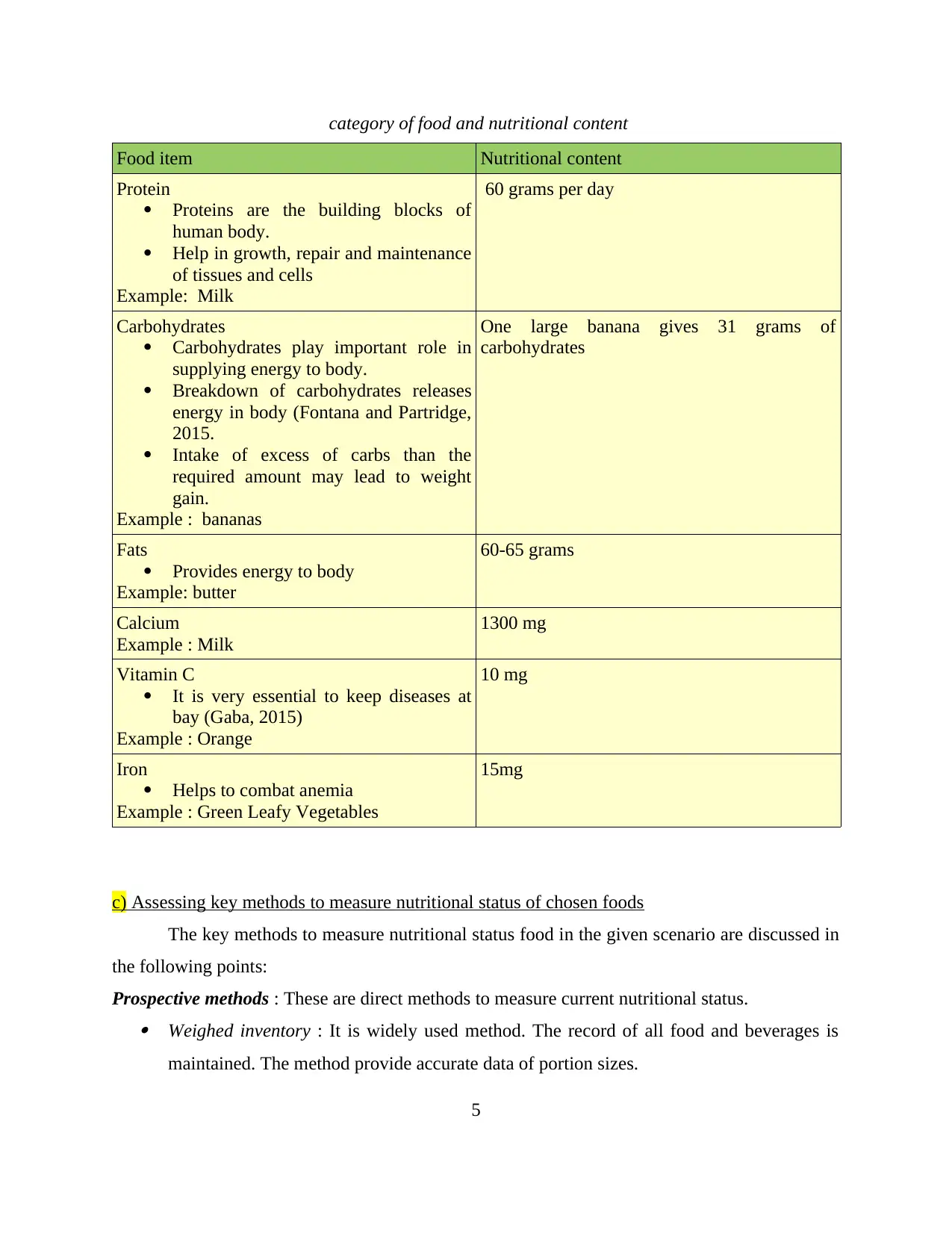
category of food and nutritional content
Food item Nutritional content
Protein
Proteins are the building blocks of
human body.
Help in growth, repair and maintenance
of tissues and cells
Example: Milk
60 grams per day
Carbohydrates
Carbohydrates play important role in
supplying energy to body.
Breakdown of carbohydrates releases
energy in body (Fontana and Partridge,
2015.
Intake of excess of carbs than the
required amount may lead to weight
gain.
Example : bananas
One large banana gives 31 grams of
carbohydrates
Fats
Provides energy to body
Example: butter
60-65 grams
Calcium
Example : Milk
1300 mg
Vitamin C
It is very essential to keep diseases at
bay (Gaba, 2015)
Example : Orange
10 mg
Iron
Helps to combat anemia
Example : Green Leafy Vegetables
15mg
c) Assessing key methods to measure nutritional status of chosen foods
The key methods to measure nutritional status food in the given scenario are discussed in
the following points:
Prospective methods : These are direct methods to measure current nutritional status. Weighed inventory : It is widely used method. The record of all food and beverages is
maintained. The method provide accurate data of portion sizes.
5
Food item Nutritional content
Protein
Proteins are the building blocks of
human body.
Help in growth, repair and maintenance
of tissues and cells
Example: Milk
60 grams per day
Carbohydrates
Carbohydrates play important role in
supplying energy to body.
Breakdown of carbohydrates releases
energy in body (Fontana and Partridge,
2015.
Intake of excess of carbs than the
required amount may lead to weight
gain.
Example : bananas
One large banana gives 31 grams of
carbohydrates
Fats
Provides energy to body
Example: butter
60-65 grams
Calcium
Example : Milk
1300 mg
Vitamin C
It is very essential to keep diseases at
bay (Gaba, 2015)
Example : Orange
10 mg
Iron
Helps to combat anemia
Example : Green Leafy Vegetables
15mg
c) Assessing key methods to measure nutritional status of chosen foods
The key methods to measure nutritional status food in the given scenario are discussed in
the following points:
Prospective methods : These are direct methods to measure current nutritional status. Weighed inventory : It is widely used method. The record of all food and beverages is
maintained. The method provide accurate data of portion sizes.
5
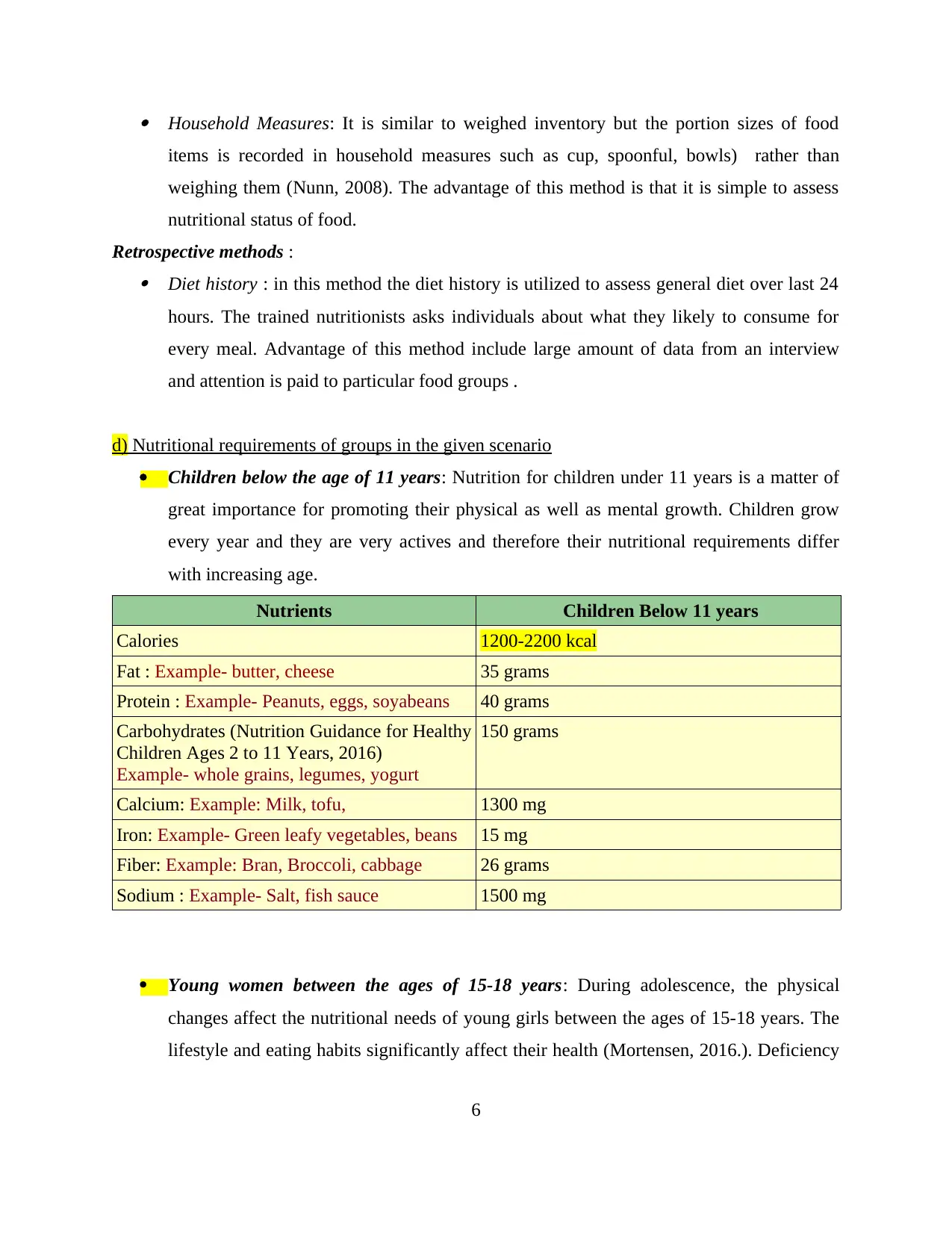
Household Measures: It is similar to weighed inventory but the portion sizes of food
items is recorded in household measures such as cup, spoonful, bowls) rather than
weighing them (Nunn, 2008). The advantage of this method is that it is simple to assess
nutritional status of food.
Retrospective methods : Diet history : in this method the diet history is utilized to assess general diet over last 24
hours. The trained nutritionists asks individuals about what they likely to consume for
every meal. Advantage of this method include large amount of data from an interview
and attention is paid to particular food groups .
d) Nutritional requirements of groups in the given scenario
Children below the age of 11 years: Nutrition for children under 11 years is a matter of
great importance for promoting their physical as well as mental growth. Children grow
every year and they are very actives and therefore their nutritional requirements differ
with increasing age.
Nutrients Children Below 11 years
Calories 1200-2200 kcal
Fat : Example- butter, cheese 35 grams
Protein : Example- Peanuts, eggs, soyabeans 40 grams
Carbohydrates (Nutrition Guidance for Healthy
Children Ages 2 to 11 Years, 2016)
Example- whole grains, legumes, yogurt
150 grams
Calcium: Example: Milk, tofu, 1300 mg
Iron: Example- Green leafy vegetables, beans 15 mg
Fiber: Example: Bran, Broccoli, cabbage 26 grams
Sodium : Example- Salt, fish sauce 1500 mg
Young women between the ages of 15-18 years: During adolescence, the physical
changes affect the nutritional needs of young girls between the ages of 15-18 years. The
lifestyle and eating habits significantly affect their health (Mortensen, 2016.). Deficiency
6
items is recorded in household measures such as cup, spoonful, bowls) rather than
weighing them (Nunn, 2008). The advantage of this method is that it is simple to assess
nutritional status of food.
Retrospective methods : Diet history : in this method the diet history is utilized to assess general diet over last 24
hours. The trained nutritionists asks individuals about what they likely to consume for
every meal. Advantage of this method include large amount of data from an interview
and attention is paid to particular food groups .
d) Nutritional requirements of groups in the given scenario
Children below the age of 11 years: Nutrition for children under 11 years is a matter of
great importance for promoting their physical as well as mental growth. Children grow
every year and they are very actives and therefore their nutritional requirements differ
with increasing age.
Nutrients Children Below 11 years
Calories 1200-2200 kcal
Fat : Example- butter, cheese 35 grams
Protein : Example- Peanuts, eggs, soyabeans 40 grams
Carbohydrates (Nutrition Guidance for Healthy
Children Ages 2 to 11 Years, 2016)
Example- whole grains, legumes, yogurt
150 grams
Calcium: Example: Milk, tofu, 1300 mg
Iron: Example- Green leafy vegetables, beans 15 mg
Fiber: Example: Bran, Broccoli, cabbage 26 grams
Sodium : Example- Salt, fish sauce 1500 mg
Young women between the ages of 15-18 years: During adolescence, the physical
changes affect the nutritional needs of young girls between the ages of 15-18 years. The
lifestyle and eating habits significantly affect their health (Mortensen, 2016.). Deficiency
6
⊘ This is a preview!⊘
Do you want full access?
Subscribe today to unlock all pages.

Trusted by 1+ million students worldwide
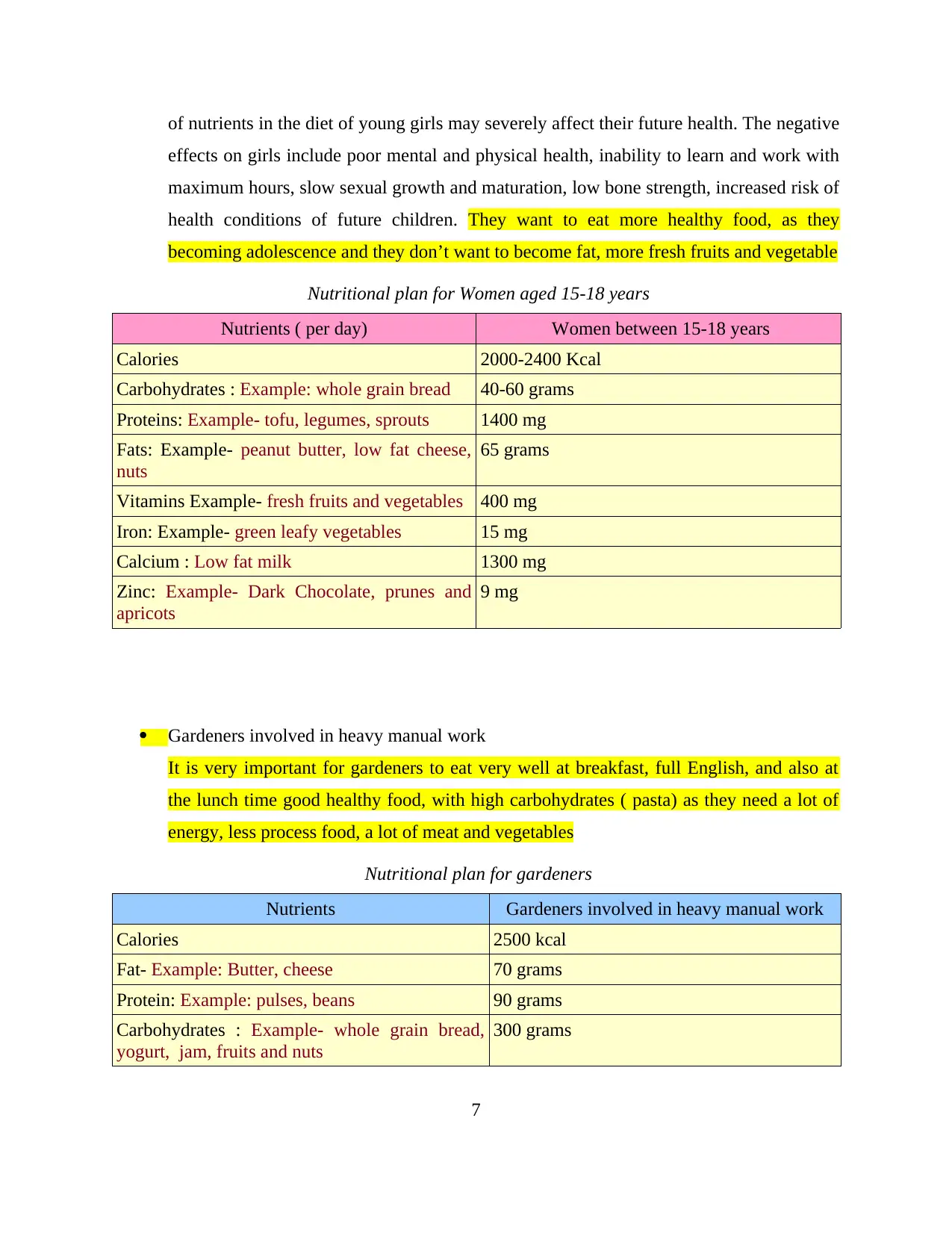
of nutrients in the diet of young girls may severely affect their future health. The negative
effects on girls include poor mental and physical health, inability to learn and work with
maximum hours, slow sexual growth and maturation, low bone strength, increased risk of
health conditions of future children. They want to eat more healthy food, as they
becoming adolescence and they don’t want to become fat, more fresh fruits and vegetable
Nutritional plan for Women aged 15-18 years
Nutrients ( per day) Women between 15-18 years
Calories 2000-2400 Kcal
Carbohydrates : Example: whole grain bread 40-60 grams
Proteins: Example- tofu, legumes, sprouts 1400 mg
Fats: Example- peanut butter, low fat cheese,
nuts
65 grams
Vitamins Example- fresh fruits and vegetables 400 mg
Iron: Example- green leafy vegetables 15 mg
Calcium : Low fat milk 1300 mg
Zinc: Example- Dark Chocolate, prunes and
apricots
9 mg
Gardeners involved in heavy manual work
It is very important for gardeners to eat very well at breakfast, full English, and also at
the lunch time good healthy food, with high carbohydrates ( pasta) as they need a lot of
energy, less process food, a lot of meat and vegetables
Nutritional plan for gardeners
Nutrients Gardeners involved in heavy manual work
Calories 2500 kcal
Fat- Example: Butter, cheese 70 grams
Protein: Example: pulses, beans 90 grams
Carbohydrates : Example- whole grain bread,
yogurt, jam, fruits and nuts
300 grams
7
effects on girls include poor mental and physical health, inability to learn and work with
maximum hours, slow sexual growth and maturation, low bone strength, increased risk of
health conditions of future children. They want to eat more healthy food, as they
becoming adolescence and they don’t want to become fat, more fresh fruits and vegetable
Nutritional plan for Women aged 15-18 years
Nutrients ( per day) Women between 15-18 years
Calories 2000-2400 Kcal
Carbohydrates : Example: whole grain bread 40-60 grams
Proteins: Example- tofu, legumes, sprouts 1400 mg
Fats: Example- peanut butter, low fat cheese,
nuts
65 grams
Vitamins Example- fresh fruits and vegetables 400 mg
Iron: Example- green leafy vegetables 15 mg
Calcium : Low fat milk 1300 mg
Zinc: Example- Dark Chocolate, prunes and
apricots
9 mg
Gardeners involved in heavy manual work
It is very important for gardeners to eat very well at breakfast, full English, and also at
the lunch time good healthy food, with high carbohydrates ( pasta) as they need a lot of
energy, less process food, a lot of meat and vegetables
Nutritional plan for gardeners
Nutrients Gardeners involved in heavy manual work
Calories 2500 kcal
Fat- Example: Butter, cheese 70 grams
Protein: Example: pulses, beans 90 grams
Carbohydrates : Example- whole grain bread,
yogurt, jam, fruits and nuts
300 grams
7
Paraphrase This Document
Need a fresh take? Get an instant paraphrase of this document with our AI Paraphraser
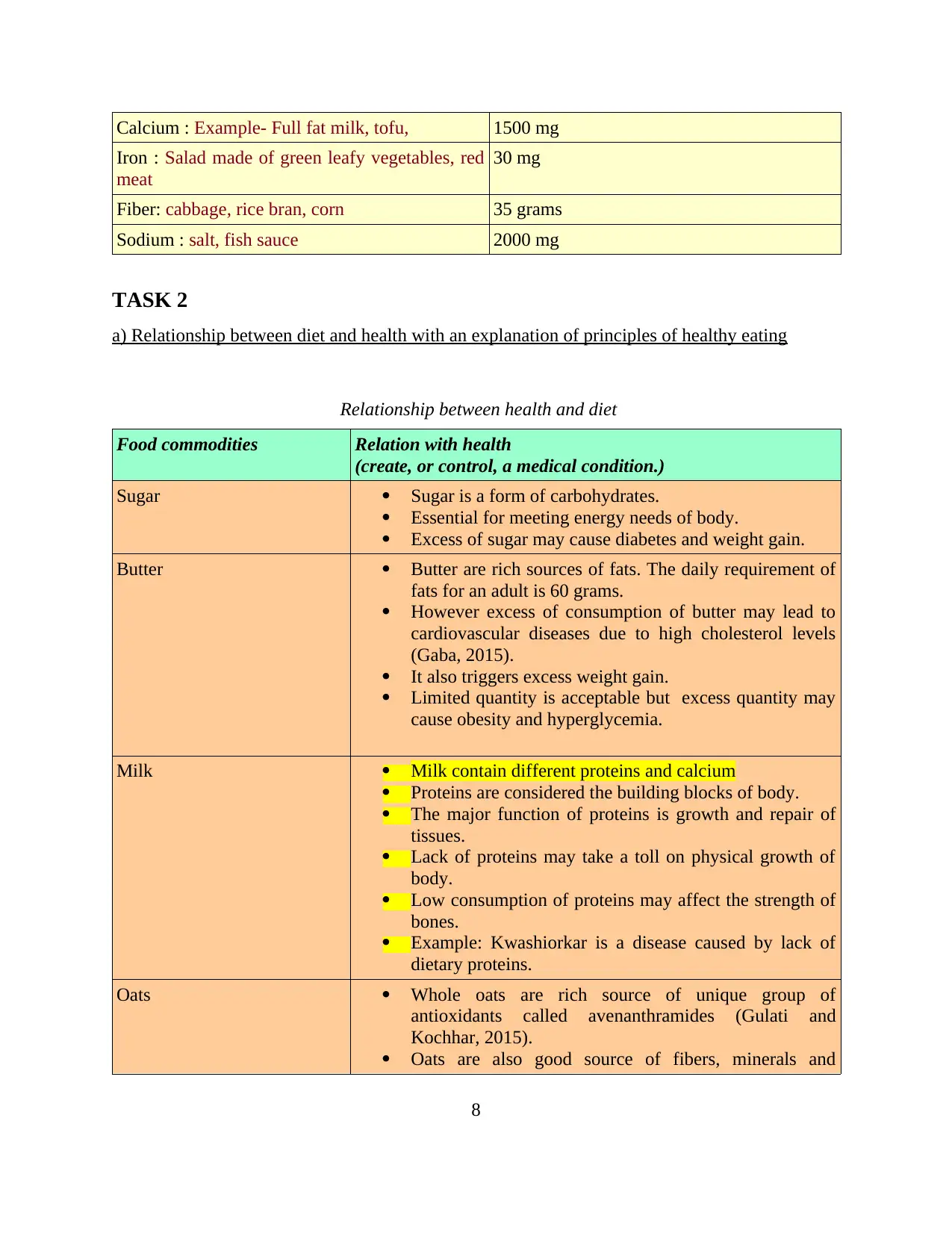
Calcium : Example- Full fat milk, tofu, 1500 mg
Iron : Salad made of green leafy vegetables, red
meat
30 mg
Fiber: cabbage, rice bran, corn 35 grams
Sodium : salt, fish sauce 2000 mg
TASK 2
a) Relationship between diet and health with an explanation of principles of healthy eating
Relationship between health and diet
Food commodities Relation with health
(create, or control, a medical condition.)
Sugar Sugar is a form of carbohydrates.
Essential for meeting energy needs of body.
Excess of sugar may cause diabetes and weight gain.
Butter Butter are rich sources of fats. The daily requirement of
fats for an adult is 60 grams.
However excess of consumption of butter may lead to
cardiovascular diseases due to high cholesterol levels
(Gaba, 2015).
It also triggers excess weight gain.
Limited quantity is acceptable but excess quantity may
cause obesity and hyperglycemia.
Milk Milk contain different proteins and calcium
Proteins are considered the building blocks of body.
The major function of proteins is growth and repair of
tissues.
Lack of proteins may take a toll on physical growth of
body.
Low consumption of proteins may affect the strength of
bones.
Example: Kwashiorkar is a disease caused by lack of
dietary proteins.
Oats Whole oats are rich source of unique group of
antioxidants called avenanthramides (Gulati and
Kochhar, 2015).
Oats are also good source of fibers, minerals and
8
Iron : Salad made of green leafy vegetables, red
meat
30 mg
Fiber: cabbage, rice bran, corn 35 grams
Sodium : salt, fish sauce 2000 mg
TASK 2
a) Relationship between diet and health with an explanation of principles of healthy eating
Relationship between health and diet
Food commodities Relation with health
(create, or control, a medical condition.)
Sugar Sugar is a form of carbohydrates.
Essential for meeting energy needs of body.
Excess of sugar may cause diabetes and weight gain.
Butter Butter are rich sources of fats. The daily requirement of
fats for an adult is 60 grams.
However excess of consumption of butter may lead to
cardiovascular diseases due to high cholesterol levels
(Gaba, 2015).
It also triggers excess weight gain.
Limited quantity is acceptable but excess quantity may
cause obesity and hyperglycemia.
Milk Milk contain different proteins and calcium
Proteins are considered the building blocks of body.
The major function of proteins is growth and repair of
tissues.
Lack of proteins may take a toll on physical growth of
body.
Low consumption of proteins may affect the strength of
bones.
Example: Kwashiorkar is a disease caused by lack of
dietary proteins.
Oats Whole oats are rich source of unique group of
antioxidants called avenanthramides (Gulati and
Kochhar, 2015).
Oats are also good source of fibers, minerals and
8
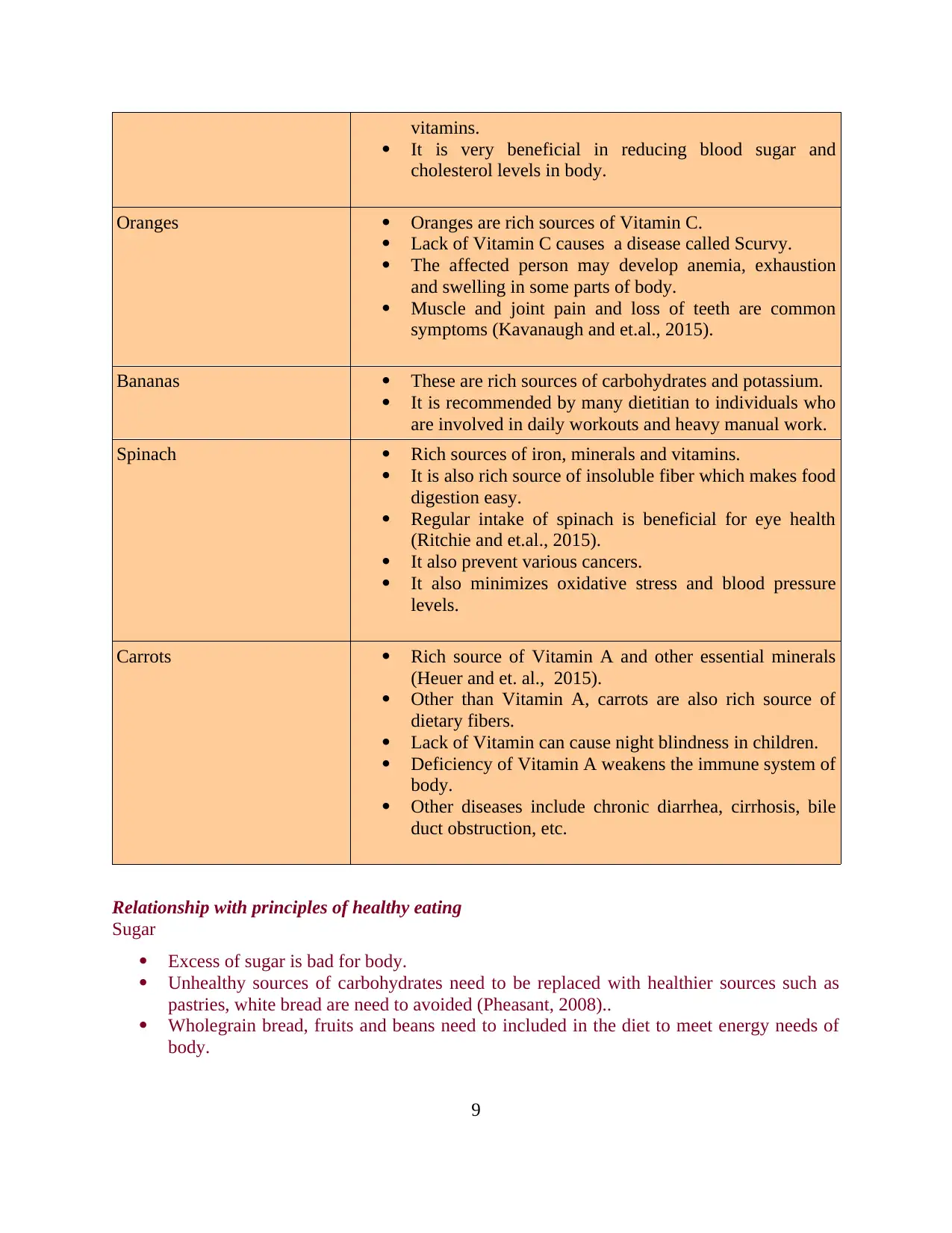
vitamins.
It is very beneficial in reducing blood sugar and
cholesterol levels in body.
Oranges Oranges are rich sources of Vitamin C.
Lack of Vitamin C causes a disease called Scurvy.
The affected person may develop anemia, exhaustion
and swelling in some parts of body.
Muscle and joint pain and loss of teeth are common
symptoms (Kavanaugh and et.al., 2015).
Bananas These are rich sources of carbohydrates and potassium.
It is recommended by many dietitian to individuals who
are involved in daily workouts and heavy manual work.
Spinach Rich sources of iron, minerals and vitamins.
It is also rich source of insoluble fiber which makes food
digestion easy.
Regular intake of spinach is beneficial for eye health
(Ritchie and et.al., 2015).
It also prevent various cancers.
It also minimizes oxidative stress and blood pressure
levels.
Carrots Rich source of Vitamin A and other essential minerals
(Heuer and et. al., 2015).
Other than Vitamin A, carrots are also rich source of
dietary fibers.
Lack of Vitamin can cause night blindness in children.
Deficiency of Vitamin A weakens the immune system of
body.
Other diseases include chronic diarrhea, cirrhosis, bile
duct obstruction, etc.
Relationship with principles of healthy eating
Sugar
Excess of sugar is bad for body.
Unhealthy sources of carbohydrates need to be replaced with healthier sources such as
pastries, white bread are need to avoided (Pheasant, 2008)..
Wholegrain bread, fruits and beans need to included in the diet to meet energy needs of
body.
9
It is very beneficial in reducing blood sugar and
cholesterol levels in body.
Oranges Oranges are rich sources of Vitamin C.
Lack of Vitamin C causes a disease called Scurvy.
The affected person may develop anemia, exhaustion
and swelling in some parts of body.
Muscle and joint pain and loss of teeth are common
symptoms (Kavanaugh and et.al., 2015).
Bananas These are rich sources of carbohydrates and potassium.
It is recommended by many dietitian to individuals who
are involved in daily workouts and heavy manual work.
Spinach Rich sources of iron, minerals and vitamins.
It is also rich source of insoluble fiber which makes food
digestion easy.
Regular intake of spinach is beneficial for eye health
(Ritchie and et.al., 2015).
It also prevent various cancers.
It also minimizes oxidative stress and blood pressure
levels.
Carrots Rich source of Vitamin A and other essential minerals
(Heuer and et. al., 2015).
Other than Vitamin A, carrots are also rich source of
dietary fibers.
Lack of Vitamin can cause night blindness in children.
Deficiency of Vitamin A weakens the immune system of
body.
Other diseases include chronic diarrhea, cirrhosis, bile
duct obstruction, etc.
Relationship with principles of healthy eating
Sugar
Excess of sugar is bad for body.
Unhealthy sources of carbohydrates need to be replaced with healthier sources such as
pastries, white bread are need to avoided (Pheasant, 2008)..
Wholegrain bread, fruits and beans need to included in the diet to meet energy needs of
body.
9
⊘ This is a preview!⊘
Do you want full access?
Subscribe today to unlock all pages.

Trusted by 1+ million students worldwide
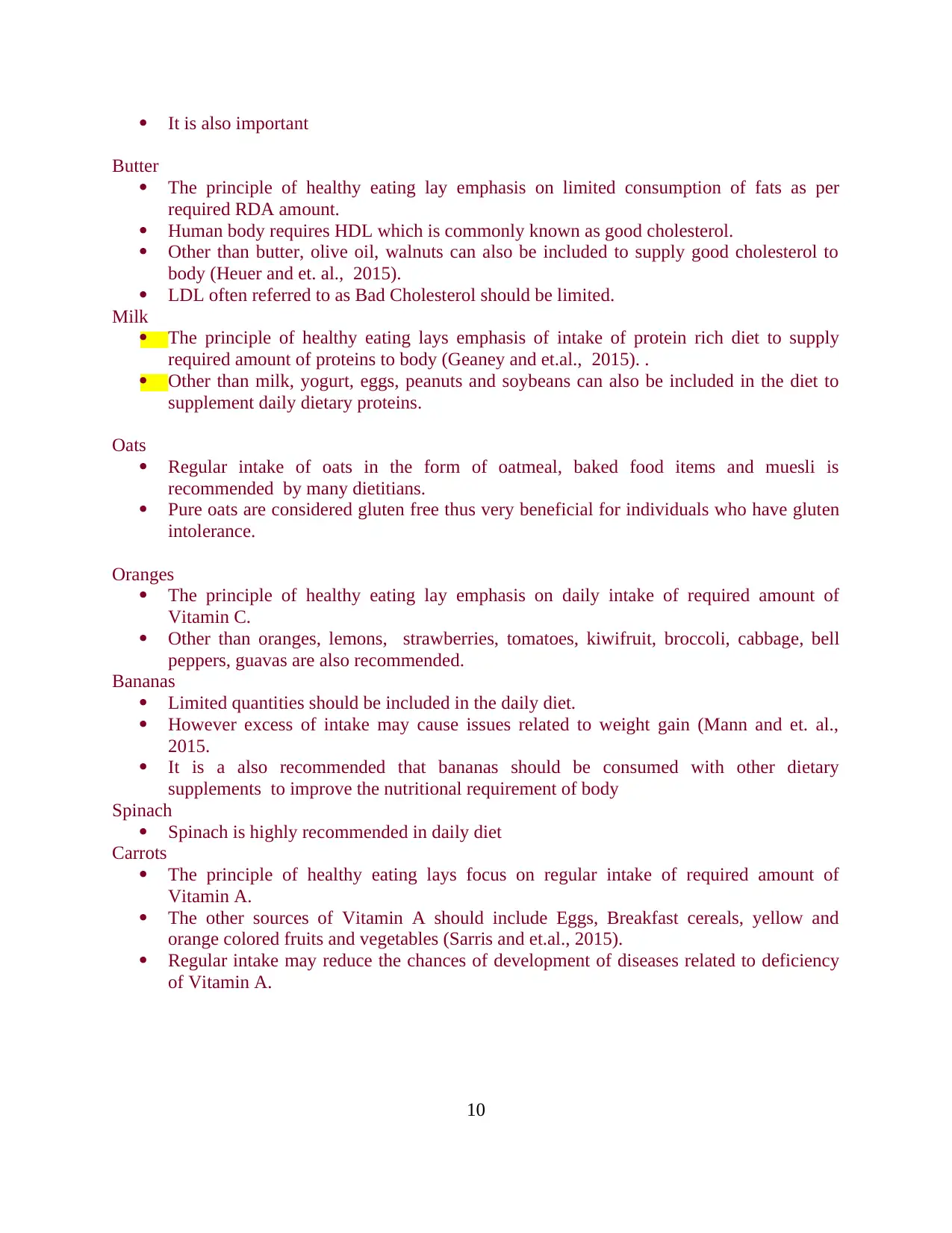
It is also important
Butter
The principle of healthy eating lay emphasis on limited consumption of fats as per
required RDA amount.
Human body requires HDL which is commonly known as good cholesterol.
Other than butter, olive oil, walnuts can also be included to supply good cholesterol to
body (Heuer and et. al., 2015).
LDL often referred to as Bad Cholesterol should be limited.
Milk
The principle of healthy eating lays emphasis of intake of protein rich diet to supply
required amount of proteins to body (Geaney and et.al., 2015). .
Other than milk, yogurt, eggs, peanuts and soybeans can also be included in the diet to
supplement daily dietary proteins.
Oats
Regular intake of oats in the form of oatmeal, baked food items and muesli is
recommended by many dietitians.
Pure oats are considered gluten free thus very beneficial for individuals who have gluten
intolerance.
Oranges
The principle of healthy eating lay emphasis on daily intake of required amount of
Vitamin C.
Other than oranges, lemons, strawberries, tomatoes, kiwifruit, broccoli, cabbage, bell
peppers, guavas are also recommended.
Bananas
Limited quantities should be included in the daily diet.
However excess of intake may cause issues related to weight gain (Mann and et. al.,
2015.
It is a also recommended that bananas should be consumed with other dietary
supplements to improve the nutritional requirement of body
Spinach
Spinach is highly recommended in daily diet
Carrots
The principle of healthy eating lays focus on regular intake of required amount of
Vitamin A.
The other sources of Vitamin A should include Eggs, Breakfast cereals, yellow and
orange colored fruits and vegetables (Sarris and et.al., 2015).
Regular intake may reduce the chances of development of diseases related to deficiency
of Vitamin A.
10
Butter
The principle of healthy eating lay emphasis on limited consumption of fats as per
required RDA amount.
Human body requires HDL which is commonly known as good cholesterol.
Other than butter, olive oil, walnuts can also be included to supply good cholesterol to
body (Heuer and et. al., 2015).
LDL often referred to as Bad Cholesterol should be limited.
Milk
The principle of healthy eating lays emphasis of intake of protein rich diet to supply
required amount of proteins to body (Geaney and et.al., 2015). .
Other than milk, yogurt, eggs, peanuts and soybeans can also be included in the diet to
supplement daily dietary proteins.
Oats
Regular intake of oats in the form of oatmeal, baked food items and muesli is
recommended by many dietitians.
Pure oats are considered gluten free thus very beneficial for individuals who have gluten
intolerance.
Oranges
The principle of healthy eating lay emphasis on daily intake of required amount of
Vitamin C.
Other than oranges, lemons, strawberries, tomatoes, kiwifruit, broccoli, cabbage, bell
peppers, guavas are also recommended.
Bananas
Limited quantities should be included in the daily diet.
However excess of intake may cause issues related to weight gain (Mann and et. al.,
2015.
It is a also recommended that bananas should be consumed with other dietary
supplements to improve the nutritional requirement of body
Spinach
Spinach is highly recommended in daily diet
Carrots
The principle of healthy eating lays focus on regular intake of required amount of
Vitamin A.
The other sources of Vitamin A should include Eggs, Breakfast cereals, yellow and
orange colored fruits and vegetables (Sarris and et.al., 2015).
Regular intake may reduce the chances of development of diseases related to deficiency
of Vitamin A.
10
Paraphrase This Document
Need a fresh take? Get an instant paraphrase of this document with our AI Paraphraser
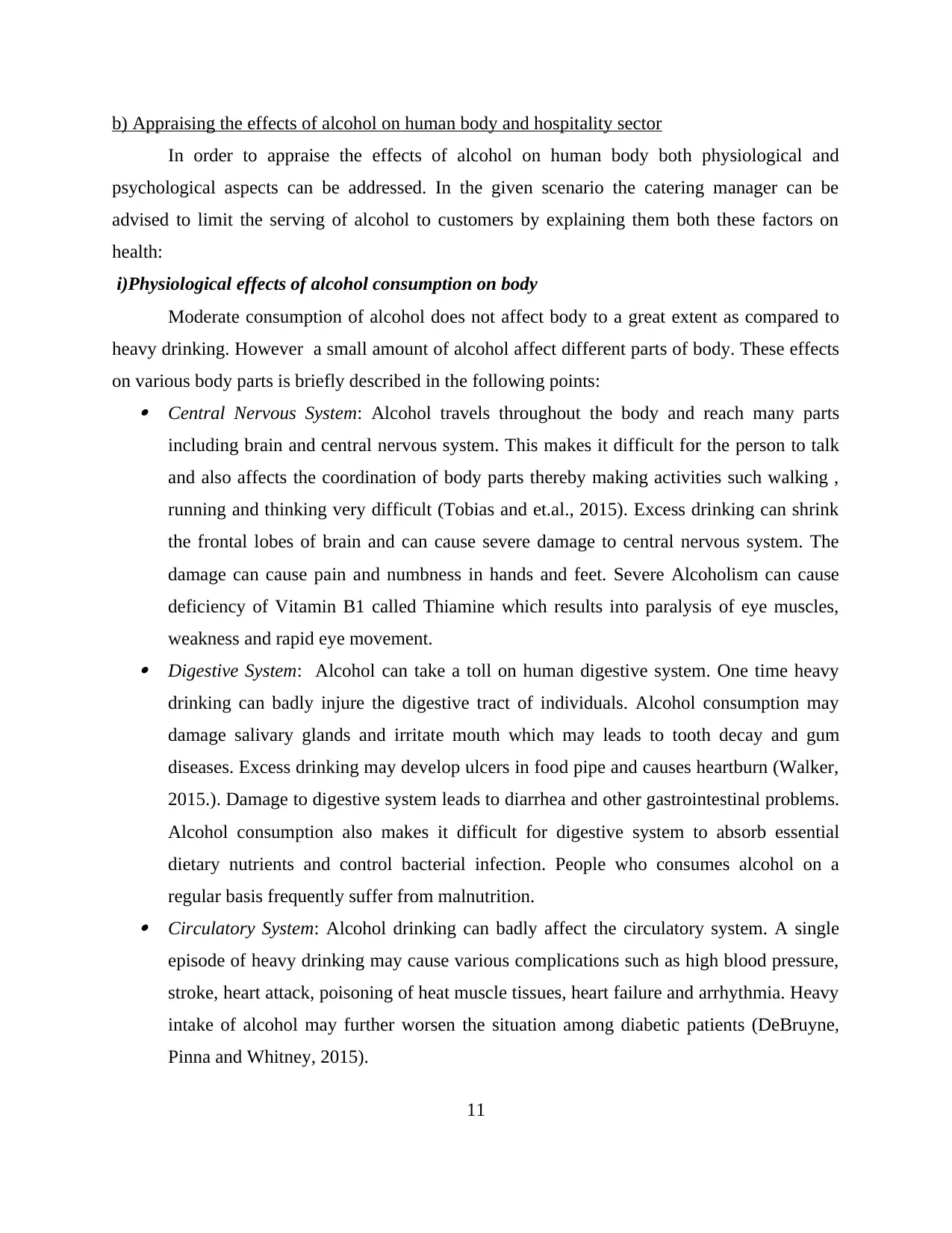
b) Appraising the effects of alcohol on human body and hospitality sector
In order to appraise the effects of alcohol on human body both physiological and
psychological aspects can be addressed. In the given scenario the catering manager can be
advised to limit the serving of alcohol to customers by explaining them both these factors on
health:
i)Physiological effects of alcohol consumption on body
Moderate consumption of alcohol does not affect body to a great extent as compared to
heavy drinking. However a small amount of alcohol affect different parts of body. These effects
on various body parts is briefly described in the following points: Central Nervous System: Alcohol travels throughout the body and reach many parts
including brain and central nervous system. This makes it difficult for the person to talk
and also affects the coordination of body parts thereby making activities such walking ,
running and thinking very difficult (Tobias and et.al., 2015). Excess drinking can shrink
the frontal lobes of brain and can cause severe damage to central nervous system. The
damage can cause pain and numbness in hands and feet. Severe Alcoholism can cause
deficiency of Vitamin B1 called Thiamine which results into paralysis of eye muscles,
weakness and rapid eye movement. Digestive System: Alcohol can take a toll on human digestive system. One time heavy
drinking can badly injure the digestive tract of individuals. Alcohol consumption may
damage salivary glands and irritate mouth which may leads to tooth decay and gum
diseases. Excess drinking may develop ulcers in food pipe and causes heartburn (Walker,
2015.). Damage to digestive system leads to diarrhea and other gastrointestinal problems.
Alcohol consumption also makes it difficult for digestive system to absorb essential
dietary nutrients and control bacterial infection. People who consumes alcohol on a
regular basis frequently suffer from malnutrition. Circulatory System: Alcohol drinking can badly affect the circulatory system. A single
episode of heavy drinking may cause various complications such as high blood pressure,
stroke, heart attack, poisoning of heat muscle tissues, heart failure and arrhythmia. Heavy
intake of alcohol may further worsen the situation among diabetic patients (DeBruyne,
Pinna and Whitney, 2015).
11
In order to appraise the effects of alcohol on human body both physiological and
psychological aspects can be addressed. In the given scenario the catering manager can be
advised to limit the serving of alcohol to customers by explaining them both these factors on
health:
i)Physiological effects of alcohol consumption on body
Moderate consumption of alcohol does not affect body to a great extent as compared to
heavy drinking. However a small amount of alcohol affect different parts of body. These effects
on various body parts is briefly described in the following points: Central Nervous System: Alcohol travels throughout the body and reach many parts
including brain and central nervous system. This makes it difficult for the person to talk
and also affects the coordination of body parts thereby making activities such walking ,
running and thinking very difficult (Tobias and et.al., 2015). Excess drinking can shrink
the frontal lobes of brain and can cause severe damage to central nervous system. The
damage can cause pain and numbness in hands and feet. Severe Alcoholism can cause
deficiency of Vitamin B1 called Thiamine which results into paralysis of eye muscles,
weakness and rapid eye movement. Digestive System: Alcohol can take a toll on human digestive system. One time heavy
drinking can badly injure the digestive tract of individuals. Alcohol consumption may
damage salivary glands and irritate mouth which may leads to tooth decay and gum
diseases. Excess drinking may develop ulcers in food pipe and causes heartburn (Walker,
2015.). Damage to digestive system leads to diarrhea and other gastrointestinal problems.
Alcohol consumption also makes it difficult for digestive system to absorb essential
dietary nutrients and control bacterial infection. People who consumes alcohol on a
regular basis frequently suffer from malnutrition. Circulatory System: Alcohol drinking can badly affect the circulatory system. A single
episode of heavy drinking may cause various complications such as high blood pressure,
stroke, heart attack, poisoning of heat muscle tissues, heart failure and arrhythmia. Heavy
intake of alcohol may further worsen the situation among diabetic patients (DeBruyne,
Pinna and Whitney, 2015).
11
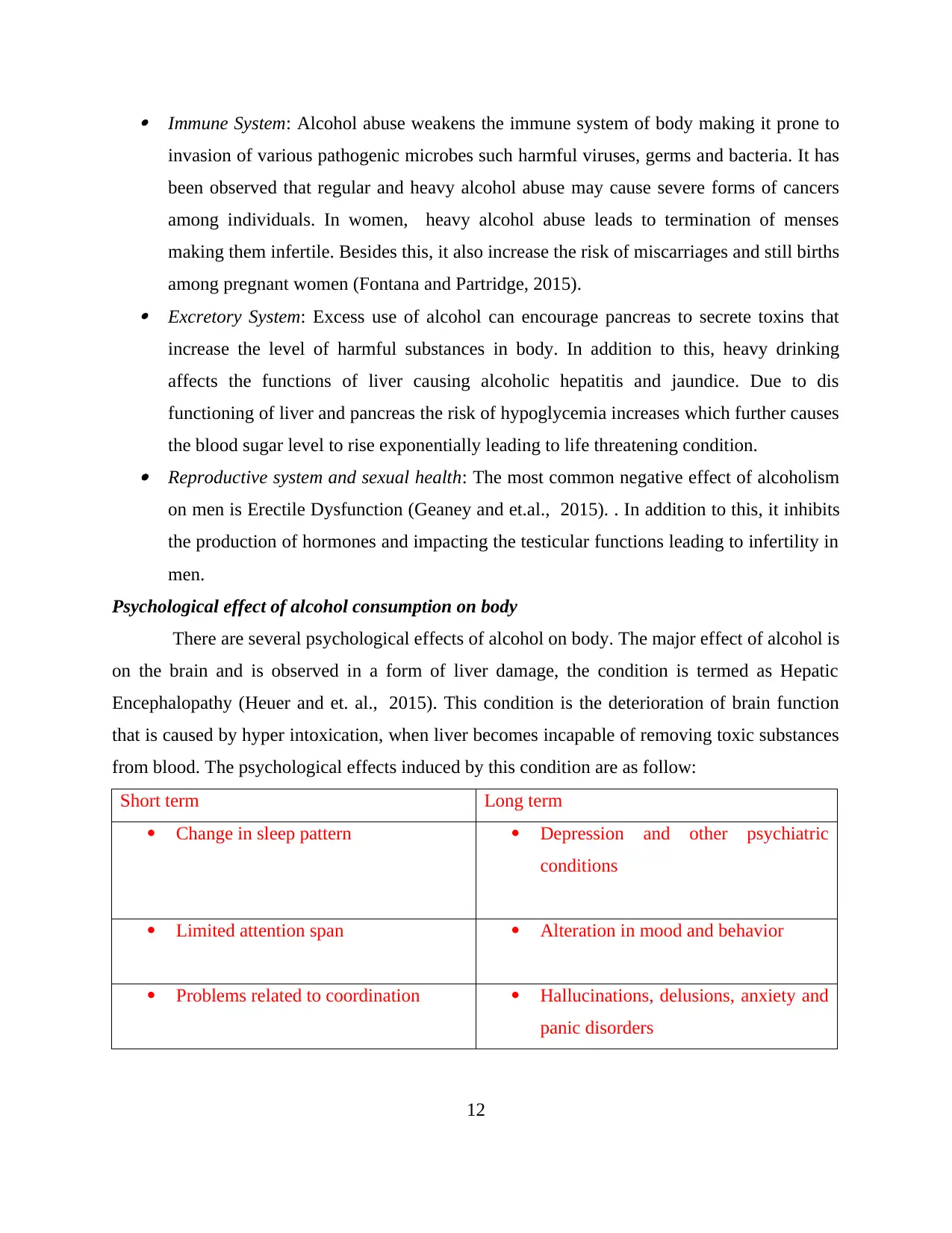
Immune System: Alcohol abuse weakens the immune system of body making it prone to
invasion of various pathogenic microbes such harmful viruses, germs and bacteria. It has
been observed that regular and heavy alcohol abuse may cause severe forms of cancers
among individuals. In women, heavy alcohol abuse leads to termination of menses
making them infertile. Besides this, it also increase the risk of miscarriages and still births
among pregnant women (Fontana and Partridge, 2015). Excretory System: Excess use of alcohol can encourage pancreas to secrete toxins that
increase the level of harmful substances in body. In addition to this, heavy drinking
affects the functions of liver causing alcoholic hepatitis and jaundice. Due to dis
functioning of liver and pancreas the risk of hypoglycemia increases which further causes
the blood sugar level to rise exponentially leading to life threatening condition. Reproductive system and sexual health: The most common negative effect of alcoholism
on men is Erectile Dysfunction (Geaney and et.al., 2015). . In addition to this, it inhibits
the production of hormones and impacting the testicular functions leading to infertility in
men.
Psychological effect of alcohol consumption on body
There are several psychological effects of alcohol on body. The major effect of alcohol is
on the brain and is observed in a form of liver damage, the condition is termed as Hepatic
Encephalopathy (Heuer and et. al., 2015). This condition is the deterioration of brain function
that is caused by hyper intoxication, when liver becomes incapable of removing toxic substances
from blood. The psychological effects induced by this condition are as follow:
Short term Long term
Change in sleep pattern Depression and other psychiatric
conditions
Limited attention span Alteration in mood and behavior
Problems related to coordination Hallucinations, delusions, anxiety and
panic disorders
12
invasion of various pathogenic microbes such harmful viruses, germs and bacteria. It has
been observed that regular and heavy alcohol abuse may cause severe forms of cancers
among individuals. In women, heavy alcohol abuse leads to termination of menses
making them infertile. Besides this, it also increase the risk of miscarriages and still births
among pregnant women (Fontana and Partridge, 2015). Excretory System: Excess use of alcohol can encourage pancreas to secrete toxins that
increase the level of harmful substances in body. In addition to this, heavy drinking
affects the functions of liver causing alcoholic hepatitis and jaundice. Due to dis
functioning of liver and pancreas the risk of hypoglycemia increases which further causes
the blood sugar level to rise exponentially leading to life threatening condition. Reproductive system and sexual health: The most common negative effect of alcoholism
on men is Erectile Dysfunction (Geaney and et.al., 2015). . In addition to this, it inhibits
the production of hormones and impacting the testicular functions leading to infertility in
men.
Psychological effect of alcohol consumption on body
There are several psychological effects of alcohol on body. The major effect of alcohol is
on the brain and is observed in a form of liver damage, the condition is termed as Hepatic
Encephalopathy (Heuer and et. al., 2015). This condition is the deterioration of brain function
that is caused by hyper intoxication, when liver becomes incapable of removing toxic substances
from blood. The psychological effects induced by this condition are as follow:
Short term Long term
Change in sleep pattern Depression and other psychiatric
conditions
Limited attention span Alteration in mood and behavior
Problems related to coordination Hallucinations, delusions, anxiety and
panic disorders
12
⊘ This is a preview!⊘
Do you want full access?
Subscribe today to unlock all pages.

Trusted by 1+ million students worldwide
1 out of 21
Related Documents
Your All-in-One AI-Powered Toolkit for Academic Success.
+13062052269
info@desklib.com
Available 24*7 on WhatsApp / Email
![[object Object]](/_next/static/media/star-bottom.7253800d.svg)
Unlock your academic potential
Copyright © 2020–2025 A2Z Services. All Rights Reserved. Developed and managed by ZUCOL.





